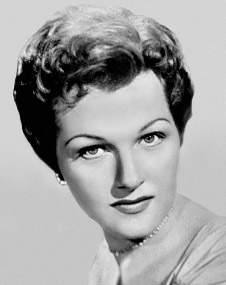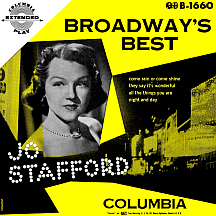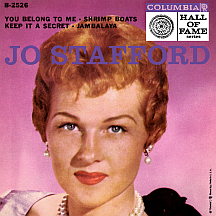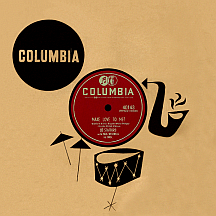JO STAFFORD
During the 1940s, when the top-billed women in the music business were usually featured vocalists in big bands, Jo Stafford and Dinah Shore each had an impressive string of hit records as solo acts. Their bandleaders (Paul Weston, in Jo's case) were satisfied to take a back seat to the talent and charisma of the beauty behind the mic. As a result, Dinah and Jo were the era's premier female singers, outselling all others. It was a close call as to which of the two was more successful in those pre-Patti Page days. When the '50s rolled around, each took a different path to retaining star status; Jo changed record labels and continued her chart-topping ways while Dinah moved, rather spectacularly, into the relatively new realm of network television.
Jo didn't start out with the idea of being a pop star. As a teenager in Los Angeles, she studied classical music in the hopes of becoming a skilled soprano, but her two older sisters, Christine and Pauline Stafford, had begun performing pop songs and after graduating from high school in 1935, Jo joined them (while younger sis Betty took a pass). As The Stafford Sisters, they appeared in the 1938 film Gold Mine in the Sky (one of several dozen westerns starring Gene Autry), performing as the fictional Levinsky Trio. The same year, the sisters had guest spots on many radio shows and supplied backing vocals for the Oscar-winning box office hit Alexander's Ragtime Band. Before long, The Four Esquires and The Three Rhythm Kings (who'd also lent their talents to the film) joined forces as one seven-man group, with Jo the eighth and only female member; the sister act wasn't entirely done, not yet anyway, as they appeared in at least two more films over the next few years. Jo and her seven fellas (Chuck Lowry, Hal Hopper, Bud Hervey, George Tait, Woody Newbury, future L.A. morning personality Dick Whittinghill and one other, John Huddleston, who became her husband) called themselves The Pied Pipers.
Axel Stordahl and Paul Weston, both arrangers for Tommy Dorsey's orchestra, were impressed enough by the group to convince Tommy to hire them for his and former vaudeville comedian Jack Pearl's top-rated Raleigh-Kool Program. Taking a two-car road trip across the U.S., the octet made quite an impression in New York with their well-rehearsed act, enhancing Axel's and Paul's arrangements with clever harmonies and intricate vocal overlays. A few songs were recorded for the Victor label ("Polly Wolly Doodle All the Day" was the Pied Pipers' debut single), then about two weeks into their ten-week radio contract, one of the show's sponsors was offended by their performance of "Hold Tight" ('...I want some seafood, mama!') and abruptly fired them all. The group decided to head back to sunny California.
Practicing regularly and going to auditions as often as possible, the group had no luck despite the note on their resumé about Dorsey's national radio show. Confidence had been shattered; doubts about their future chances at success began to take its toll and five members called it quits. Only Huddleston, Lowry and Stafford remained with the addition of Billy Wilson. Continued rejection took its toll and they began joking about changing the quartet's name to "Poverty Inc." Wilson had quit by late '39 when Dorsey contacted them with a new offer; they would be working with an up-and-coming singer previously with Harry James' band, some guy by the name of Frank Sinatra, who'd been hired to do lead vocals. Paul Weston left at about that time and spent the next couple of years as Dinah Shore's arranger...so he wasn't around for the explosion that came directly: Sinatra and the Pied Pipers supplied the vocals for "I'll Never Smile Again," Dorsey's number one hit of the summer and fall of 1940 (Billboard's first "official" chart-topper).
The first label credit for Jo came in early '41 with "Little Man With a Candy Cigar," then she and Sy Oliver supplied the vocals, with label credit, for Dorsey's "Yes Indeed!," which reached the top ten of the sales charts in the summer of 1941. Another Dorsey chart-topper, "There Are Such Things," came in January '43 with Sinatra and the Pied Pipers, though by that time the quartet had moved on after a Thanksgiving 1942 argument with Tommy ended with the entire group quitting. Once again they returned to Southern Cal, much more famous than before, and quickly picked up radio gigs. Johnny Mercer signed them to his brand new, Hollywood-headquartered Capitol Records and it just so happened that Paul Weston was hired as the label's musical director; the Pied Pipers ranked among Capitol's earliest hitmaking acts.
For the first year or so, Jo established herself as a solo act while continuing as a member of the Pied Pipers. Her marriage to Huddleston hit a rough spot and they divorced; he left the group to join the Army (at the height of World War II) and was replaced by previous Piper Hal Hopper. The first solo Stafford hit, "Old Acquaintance," came near the end of 1943, followed in the spring of '44 by a double-sided top ten platter, Cole Porter's "I Love You" and the Jerome Kern-Ira Gershwin ballad "Long Ago and Far Away," a best Original Song Oscar nominee from Cover Girl starring Gene Kelly and Rita Hayworth. The Pied Pipers scored again that year with the hits "Mairzy Doats" and "The Trolley Song" (a signature tune for Judy Garland from Meet Me in St. Louis, though the P.P. version went higher on the charts: all the way to number two). Capitol bossman Mercer had his own string of hits going as a songwriter and singer; for the spring '45 smash "Candy" (that's what 'I call my sugar...'), he duetted with Jo and the Pipers, one of the biggest hits for all three in any configuration.
Surrendering to the inevitable, Jo became a full-time solo act in 1945. June Hutton, who'd logged time as a singer for Charlie Spivak's vocal group The Stardusters, replaced her in the Pied Pipers with remaining members Hopper, Lowry and Yokum. Soldiers fighting overseas became some of Stafford's biggest fans and she was given the nickname "G.I. Jo." Radio stints included The Chesterfield Supper Club and her own Jo Stafford Show. After the war, she cut back on live performing, preferring radio and studio work. "That's For Me" and "Symphony," both top tens, were her biggest hits in 1945 and '46.
Popularity polls in magazines of the '40s frequently ranked Jo at or near the top; the classical training as a teen proved useful, giving her a wider range than the typical pop star. Yet some might say she stooped to a lower level with a 1947 project that yielded incredible dividends. Master fiddler Red Ingle, formerly a member of Spike Jones and his City Slickers, started his own group The Natural Seven and signed with Capitol Records. A string of parody songs followed; in 1947 he reconfigured "Temptation," a Nacio Herb Brown-Arthur Freed song introduced by Bing Crosby in the 1933 film Going Hollywood. Jo was asked to supply vocals; label execs, uncertain as to its commercial potential, didn't want her own momentum affected by a shift in public perception, so she and Red came up with an alias, Cinderella G. Stump. "Temptation (Tim-Tayshun)" (its lyrics sung with an exaggerated "hillbilly" twang) became popular very quickly (a number two pop and C&W hit that summer) and once the identity of "Cinderella" was revealed, sales flew past the million mark.
She didn't immediately move away from country novelties; "Feudin' and Fightin'" (from the Broadway musical Laffing Room Only starring Betty Garrett), sung by Jo in a Stump-ish style with The Starlighters (former members of Six Hits and a Miss, the "miss" being Pauline Byrns), was a top ten pop hit in September '47. After a few more "regular" hits (including the year-end top ten "Serenade of the Bells"), Jo resumed her inclination for collaboration, teaming with Broadway and film star Gordon MacRae on several hits including "Bluebird of Happiness" in '48, "My Darling, My Darling," "'A' You're Adorable" and "Whispering Hope" in '49, then "Bibbidi-Bobbidi-Boo (The Magic Song)" (from Walt Disney's Cinderella!) and "Dearie" in 1950.
A radio regular in the early '50s, she spent about two years on The Carnation Contented Hour with Tony Martin (its sponsor, of course, was Carnation milk with its "contented cows") and Club Fifteen with Bob Crosby. As her contract with Capitol wound down, she scored hits with "Play a Simple Melody" and "No Other Love" before moving to Columbia Records in the fall of 1950. Her version of Pee Wee King and Redd Stewart's "Tennessee Waltz" was overshadowed by Patti Page's multi-million-seller...but she wasn't ready to step aside for "The Singing Rage" just yet. Starting with "Pretty Eyed Baby" in the spring of '51, Jo enjoyed collaborating with recent Mercury Records defector Frankie Laine over the next couple of years (billing on singles alternated between the two, unlike her situation with MacRae where she was always shown first). She and Laine had a lot of fun in the studio and several more hits resulted, including Hank Williams' "Hey, Good Lookin'," Terry Gilkyson's "Gambella (The Gamblin' Lady)" and Red Saunders' "Hambone."

A new single was released nearly every month during 1951, duets or solo efforts frequently holding two or even three slots simultaneously in the top 20. "Shrimp Boats" ('...is a-comin', their sails are in sight!'), composed by noted zither player Paul Mason Howard and Jo's longtime bandleader Weston, capped off the year in grand style, reaching number two on the charts in December. As big as '51 was, the following year brought several highlights; Jo and Paul were married in February (their union lasting through his death 44 years later). Her recording of "You Belong to Me" ('See the pyramids along the Nile...'), a song penned by King and Stewart with Kentuckian Chilton Price, became the nation's number one song throughout October and November. But that was only the half of it; while Hank Williams' hunger-inducing smash "Jambalaya" perched at the top of the country charts and "You Belong" had the number one pop spot, Jo's fun cover of the Williams tune hovered just below the apex.
The Jessie Mae Robinson song "Keep it a Secret" reached its top ten peak in January 1953, around the time Jo returned to radio with The Jo Stafford Show, which aired weekdays for about five months. Then in early 1954, she topped the charts again with "Make Love to Me!" (it took eight songwriters to craft the melody and lyrics!); the bright, vocally assertive number was the hit of the spring (though the same could be said for its main competition, the more demure "Secret Love" by Doris Day). During this time, Stafford made the jump to television, hosting a 15-minute weekly version of The Jo Stafford Show that ran through June 1955. She was honored with an Emmy nomination for Best Female Singer, but lost the award to her old nemesis, the still-lurking Dinah Shore, who in 1956 made a sensational transition into the video medium with the hourlong Dinah Shore Chevy Show (a high-rated variety series that ran on NBC through 1963 and lined her mantle with five more Emmys).
In 1955, Jo Stafford was awarded a platinum plaque commemorating sales of over 25 million records - so rare a feat that she was the first female singer to reach that mark. Sales of her singles and albums tapered off as rock and roll and teen music rose in popularity; her final top 40 hit was "On London Bridge" in late 1956. With husband Paul's help, she reinvented her act; Weston had been working on comedy routines as an off-kilter lounge pianist, an unconventional concept to say the least. In 1957 he recorded an album, The Piano Artistry of Jonathan Edwards, featuring his wife "Darlene" doing cringe-worthy vocals. Much like the Cinderella G. Stump gag of ten years earlier, their hidden identities were soon revealed, leading to a series of comedic albums over the next decade, always with covers that avoided showing who they really were. In 1961, Paul and Jo's album Jonathan and Darlene Edwards in Paris won a Grammy for Best Comedy Performance, Musical.
She spent some time in England during 1961, hosting a series of TV specials, again titled The Jo Stafford Show, with bandleader Jack Parnell (a 1959 guest spot on his uncle Val Parnell's Sunday Night at the Palladium had gone so well she accepted an offer to do an expanded version). Returning to Capitol, she recorded albums in a number of genres, receiving another Grammy nomination in 1964 for her album Jo Stafford's Sweet Hour of Prayer in the category Best Gospel or Other Religious Recording, Musical. It boggles the mind to imagine how many such awards she could have won had the Grammys existed during her heyday. Singles were released sporadically on Colpix ("Misty"), Reprise ("Country Bumpkin") and Dot ("Cry, Cry Darling") between 1962 and '66. Throughout the course of a four-decade career, she recorded over 800 songs; in the 1970s, the Westons worked out a deal with Columbia Records to purchase Jo's master recordings, a rare thing for a major artist. Many compilations of her '50s hits were released afterwards on their own Corinthian label.
Jo Stafford put together one of the most impressive resumés in the history of recorded music; her marriage to Weston remained strong and she gradually settled into family life outside the spotlight. Dinah Shore, meanwhile, remained visible on TV (covering the entire decade of the '70s with two daytime talk shows, Dinah's Place and Dinah!). For years there has been a debate as to which of the two singers was the Queen of the Big Band era: "America's Darling Daughter" Dinah? Or effervescent Stafford sister "G.I. Jo"?
NOTABLE SINGLES:
- I'll Never Smile Again - 1940
by Tommy Dorsey with Frank Sinatra and the Pied Pipers - Little Man With a Candy Cigar - 1941
by Tommy Dorsey with Jo Stafford - Yes Indeed! - 1941
by Tommy Dorsey with Sy Oliver and Jo Stafford - There Are Such Things - 1943
by Tommy Dorsey with Frank Sinatra and the Pied Pipers - Old Acquaintance - 1943
- I Love You /
Long Ago and Far Away - 1944 - Mairzy Doats - 1944
by the Pied Pipers - It Could Happen to You - 1944
- The Trolley Song - 1944
by the Pied Pipers - Candy - 1945
by Johnny Mercer, Jo Stafford and the Pied Pipers - There's No You - 1945
- That's For Me - 1945
- Symphony - 1946
- Temptation (Tim-Tayshun) - 1947
by Red Ingle and the Natural Seven with Cinderella G. Stump - Feudin' and Fightin' - 1947
with the Starlighters - Serenade of the Bells - 1947
- Ev'ry Day I Love You (Just a Little Bit More) - 1948
- Bluebird of Happiness - 1948
by Jo Stafford and Gordon MacRae / - Say Something Sweet to Your Sweetheart - 1948
by Jo Stafford and Gordon MacRae - My Darling, My Darling - 1949
by Jo Stafford and Gordon MacRae - "A" You're Adorable - 1949
by Jo Stafford and Gordon MacRae / - Need You - 1949
by Jo Stafford and Gordon MacRae - Some Enchanted Evening - 1949
- Whispering Hope - 1949
by Jo Stafford and Gordon MacRae - Bibbidi-Bobbidi-Boo (The Magic Song) - 1950
by Jo Stafford and Gordon MacRae - Dearie - 1950
by Jo Stafford and Gordon MacRae - Play a Simple Melody - 1950
- No Other Love - 1950
- Goodnight, Irene - 1950
- Tennessee Waltz - 1951
- It is No Secret - 1951
- Pretty Eyed Baby - 1951
by Jo Stafford and Frankie Laine - Hey, Good Lookin' - 1951
by Frankie Laine and Jo Stafford / - Gambella (The Gamblin' Lady) - 1951
by Jo Stafford and Frankie Laine - Shrimp Boats - 1951
- Ay-Round the Corner - 1952
- Hambone - 1952
by Frankie Laine and Jo Stafford - You Belong to Me - 1952
- Jambalaya - 1952
- Settin' the Woods on Fire - 1952
by Jo Stafford and Frankie Laine - Keep it a Secret - 1953
- Now and Then, There's a Fool Such as I - 1953
- Make Love to Me! - 1954
- Thank You For Calling - 1954
- Teach Me Tonight - 1954
- Suddenly There's a Valley - 1955
- It's Almost Tomorrow - 1955
- All Night Long - 1956
- With a Little Bit of Luck - 1956
- Love Me Good - 1956
- On London Bridge - 1956
- Wind in the Willow - 1957
- Pine Top's Boogie - 1959
- Misty - 1962
- If My Heart Had a Window - 1962
- Country Bumpkin - 1963
- Cry, Cry Darling - 1966




